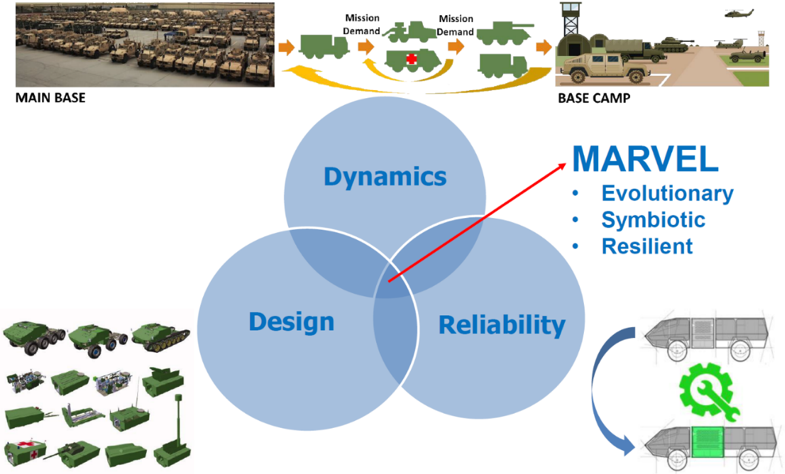Systems of Systems & Integration
integrativeFinding the MARVEL in the Hay Stack: A Case Study on Modular Adaptive Resilient Vehicle Fleets
Project Summary
Case study was performed in 2017.
Contributors (TA 5): Bogdan Epureanu, Panos Papalambros, A. Emrah Bayrak†, Mert Egilmez†, Xingyu Li†, Arianne Collopy† (UM), Zissimos Mourelatos, Themistoklis Koutsellis† (OU), Matthew Castanier, Richard Gerth, Michael Kerr, Chad Wilson (GVSC), Jeff Bradel (ONR), Ra’ed Seifeldin (Vencore) Edward Umpfenbach (General Motors), Terrance Wagner (Ford Motor Company), Randy Jaeger, Clint Hope (Applied Minds) (†Students)

Revolutionary adaptability and resilience are two of the key needs of the 3rd offset. Paradigm changes are required in fleet operation and design to accomplish these needs. Modularity promises to provide significant benefits in terms of adaptability and resilience especially when combined with autonomy through self-assembly and self-reconfiguration. Modular autonomous systems are complex systems of systems, which require advanced design and management approaches. This case study presented a unique approach to the design, dynamic operation and reliability of modular vehicle systems. The design study refers to a systematic process for decisions to generate modular design concepts to create the vehicle fleets of the 3rd offset; dynamic operation addressed the fleet management to schedule and conduct on-base and in-theatre missions such as vehicle assembly, resupply and convoy operations considering the entire fleet dynamics; and reliability analysis modeled the failures in the fleet as a repairable system based on limited observations, and provided quantitative predictions for future failures based on previous ones to enhance the overall system reliability. The analysis in this case study was applied to the Vehicle Agnostic Modularity (VAM) program of the Office of Naval Research to support decisions from design to deployment and operation of innovative modular vehicle fleet concepts; VAM seeks to assess the efficacy of modularity to the USMC ground vehicle fleet.
In the demonstration scenario, the modular fleet showed a better recovery than conventional fleet with a 8.5% reduction in repair time with modular fleet. There was also a 74% average fleet readiness with modular fleet compared to 71% with conventional fleet.
Publications:
Bayrak, A. E., Egilmez, M. M., Kuang, H., Li, X., Park, J. M., Umpfenbach, E., … & Epureanu, B. I. (2018). A system-of-systems approach to the strategic feasibility of modular vehicle fleets. IEEE Transactions on Systems, Man, and Cybernetics: Systems, 50(7), 2716-2728.
A. E. Bayrak, M. M. Egilmez, H. Kuang, X. Li, J. M. Park, E. Umpfenbach, E. Anderson, D. Gorisch, J. Hu, P. Y. Papalambros, B. I. Epureanu, “A System-of-Systems Approach to the Strategic Feasibility of Modular Vehicle Fleets,” in IEEE Transactions on Systems, Man, and Cybernetics: Systems, pp. 1-13, May 2018.

